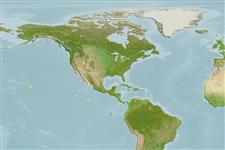>
Perciformes/Zoarcoidei (Eelpouts and pricklebacks) >
Zoarcidae (Eelpouts) > Lycodinae
Etymology: Lycenchelys: Greek, lykos = wolf + Greek, enchelys, -yos = eel (Ref. 45335); folletti: Named in honor of Mr. Wilbur Irving ("Bill") Follett, late curator in the Department of Ichthyology, California Academy of Sciences.
Eponymy: Wilbur Irving ‘Bill’ Follett (1901–1992) was a lawyer by profession but an ichthyologist by choice. He was Curator, Department of Ichthyology, California Academy of Sciences (1947–1969). (Ref. 128868), visit book page.
Environment: milieu / climate zone / depth range / distribution range
Ecologia
marinhas batidemersal; intervalo de profundidade 660 - 953 m (Ref. 35910). Deep-water
Eastern Central Pacific: Gulf of California to central Mexico.
Tamanho / Peso / Idade
Maturity: Lm ? range ? - ? cm
Max length : 15.8 cm TL macho/indeterminado; (Ref. 35910)
Maximum length based on a juvenile specimen. Feeds on gastropods.
Ciclo de vida ou comportamento de acasalamento
Maturidade | Reprodução | Desova | Ovos | Fecundidade | Larvas
Anderson, M.E., 1995. The eelpout genera Lycenchelys Gill and Taranetzella Andriashev (Teleostei: Zoarcidae) in the eastern Pacific, with descriptions of nine new species. Proc. Calif. Acad. Sci. 49(2):55-113. (Ref. 35910)
Status na Lista Vermelha da UICN (Ref. 130435: Version 2024-1)
Ameaça para os humanos
Harmless
Uso pelos humanos
Ferramentas
Relatórios especiais
Baixar XML
Fontes da internet
Estimates based on models
Preferred temperature (Ref.
123201): 4.3 - 4.9, mean 4.5 °C (based on 5 cells).
Índice de diversidade filogenética (Ref.
82804): PD
50 = 0.5000 [Uniqueness, from 0.5 = low to 2.0 = high].
Bayesian length-weight: a=0.00120 (0.00058 - 0.00248), b=3.10 (2.91 - 3.29), in cm total length, based on LWR estimates for this (Sub)family-body shape (Ref.
93245).
Nível Trófico (Ref.
69278): 3.4 ±0.58 se; based on food items.
Resiliência (Ref.
120179): médio(a), tempo mínimo de duplicação da população 1,4 - 4,4 anos (Assuming tmax>3).
Fishing Vulnerability (Ref.
59153): Low vulnerability (10 of 100).
